Planting a pecan tree from a nut is a satisfying journey that starts with careful planning and attention to detail. This guide will help you learn how to grow pecan trees successfully so you can watch them grow into strong, mature trees. When you think about growing pecans from seed, several key factors come into play, such as pecan seed germination, suitable soil preparation, and tree planting.
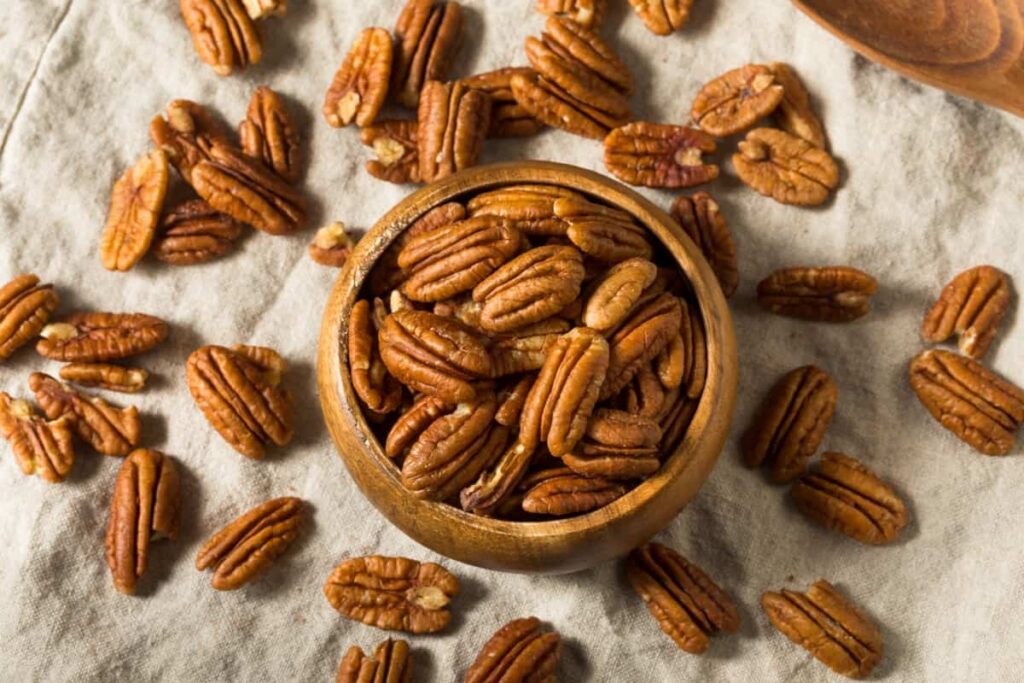
How fast do pecan trees grow, and how long do pecan trees live? These are essential considerations in managing expectations and ensuring your pecan trees’ long-term health and productivity. Furthermore, understanding aspects such as how deep to plant pecan seeds, where to buy pecan seeds, and the appropriate pecan plant spacing is vital for your endeavor to learn how to grow a pecan tree.
How to Grow a Pecan Tree From a Nut
Pecan Seed Germination Process
Growing a pecan tree from a nut begins with pecan seed germination. Selecting healthy, mature pecan seeds for planting is essential to increase the chances of successful germination. Start by soaking the nuts in water for 24 to 48 hours. This helps in softening the shell and preparing the seed for germination. Post-soaking, the seeds should be subjected to a process known as stratification.
Stratification involves keeping the seeds in a cold environment, mimicking winter conditions, which is crucial in triggering the germination process. You can achieve this by storing the seeds in a plastic bag with a damp substrate like peat moss and keeping them in a refrigerator for about 60 to 90 days. Once the stratification process is complete, the seeds are ready to be planted for further growth and development.
Preparing the Soil for Planting Pecan Trees
A pivotal step in growing a pecan tree is correctly preparing the soil to facilitate pecan seedlings’ healthy growth. Begin by choosing a location that receives ample sunlight, ensuring that the trees have access to essential resources for growth. The soil should be well-draining with a slightly acidic to neutral pH level.
In case you missed it: How to Germinate Seeds: Techniques for Faster Germination of Vegetables, Flowers, Fruits, and Herbs
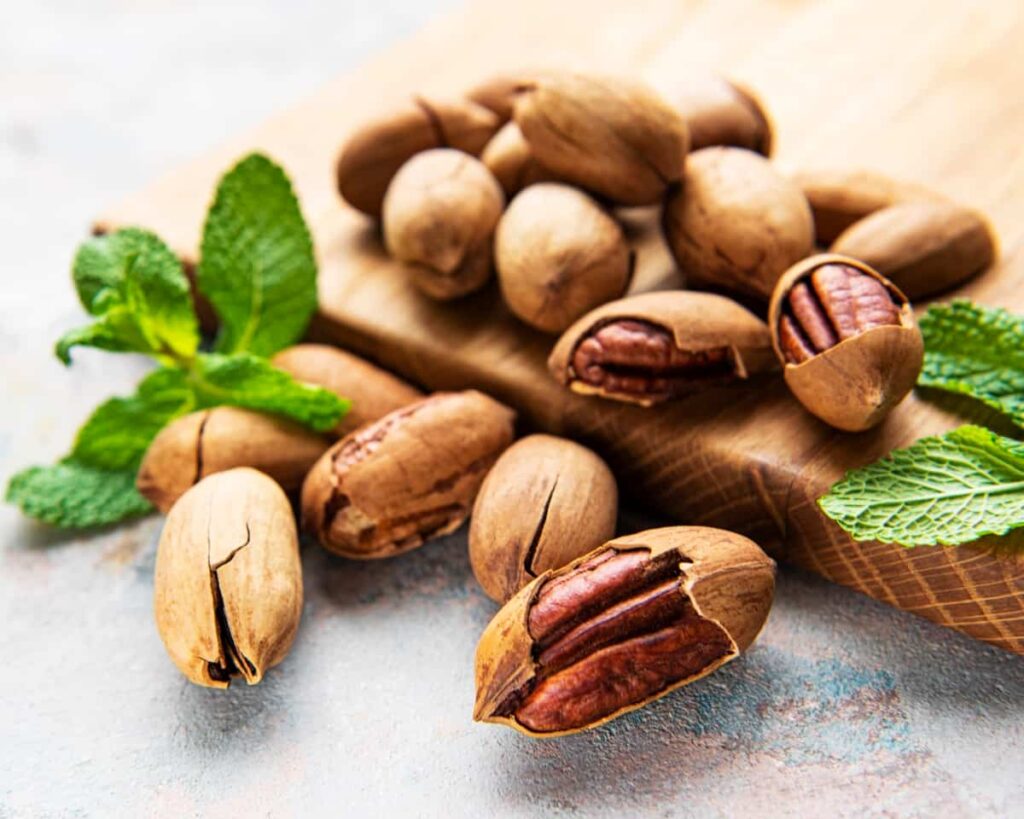
You might want to conduct a soil test to determine the existing conditions and amend the soil as necessary with organic matter or fertilizers to achieve the desired soil composition. Proper soil preparation enhances the capacity of the soil to support the trees in their growth phases, ensuring that the environment is conducive to developing strong and healthy pecan trees.
Planting Pecan Trees: A Step-by-Step Guide
The next stage involves planting the pecan trees after preparing the soil and ensuring that the pecan seed germination process is successfully completed. Start digging a deep and wide hole to accommodate the pecan seedlings’ root system comfortably. Remember, how deep to plant pecan seeds is crucial – the hole should be about 3-4 feet deep and wide. Place the germinated seeds in the hole and cover them with soil, ensuring the roots are spread out and not crowded.
Pecan plant spacing is another vital consideration; ensure each tree is planted at least 40 feet apart. This distance is crucial for allowing each tree enough space to grow without competing for essential resources. Water the trees generously after planting and maintain a consistent watering schedule, especially during the initial growth phases. Keep an eye on the growth of the trees, and be patient, as the reward of fresh pecans is well worth the wait and effort.
The Best Time to Plant a Pecan Tree
Planting a pecan tree at the right time ensures healthy growth and development. The ideal time to start this journey is in late winter or early spring, when the tree can settle its roots in the new place before it starts growing strongly. This helps it grow better. Choosing the correct planting time is a strategic decision that significantly determines the success of growing a pecan tree from a nut. It enables the tree to acclimate to its new surroundings, ensuring it is robust and ready to flourish in warmer months.
Pecan Plant Spacing and How Deep to Plant Pecan Seeds
Understanding and implementing correct pecan plant spacing and depth when planting pecan seeds are critical aspects of cultivating a healthy and thriving tree. The seeds should be planted in about 3-4 feet deep holes, allowing enough space for the roots to establish and grow. This depth provides a stable foundation for the tree, ensuring it is firmly anchored in the ground.
In case you missed it: How to Grow Alfalfa Microgreens from Seed: A Step-by-Step Seed Germination Guide
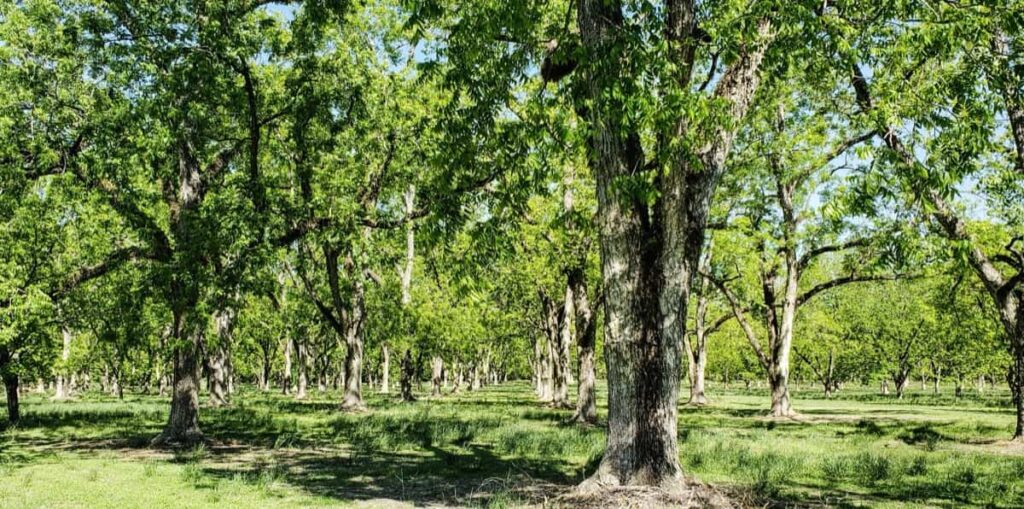
Pecan plant spacing is another crucial factor, with each tree needing about 40 feet of space from other trees. This spacing allows each tree access to essential resources such as sunlight and nutrients, preventing competition and ensuring each tree can grow and expand without hindrance.
Caring for Pecan Seedlings: Watering, Fertilizing, and Pruning
Taking care of pecan seedlings requires consistent effort and attention, focusing on essential practices like watering, fertilizing, and pruning. Regular watering is vital, especially during the initial stages, ensuring the seedlings receive enough moisture to facilitate growth. The soil should be moist, not waterlogged, promoting a healthy root system.
Fertilizing the seedlings is also essential in providing them with the necessary nutrients to thrive. Use a balanced fertilizer to enhance the soil’s nutrient content, supporting the growth and development of the trees. Trimming is important, too. It keeps the tree in good shape, removes sick branches, and helps it stay healthy and productive.
Pecan Tree Growth Stages: Life Cycle of the Tree
Understanding the growth stages of a pecan tree is vital for appropriate care and maintenance. The life cycle begins with germination, where the tree journeys from a seed to a mature tree. Following germination, the seedling stage is where the plant starts developing roots and foliage, gradually transforming into a young tree.
As the tree grows, it enters the sapling phase, becoming more substantial and resilient. The tree then progresses to the maturity stage, where it begins to produce nuts, marking its arrival into its full productive phase. Recognizing each growth stage is essential as it helps provide targeted care, ensuring that the tree navigates through each phase effectively, resulting in a healthy and productive pecan tree.
Pecan Tree Growth Rate: How Fast Do Pecan Trees Grow?
Understanding the pecan tree growth rate is essential to managing expectations and providing the necessary care at various stages of development. Pecan trees are relatively slow-growing but can reach impressive sizes over time. In their early years, these trees focus on establishing a robust root system, and visible growth may seem gradual.
However, pecan trees exhibit a more pronounced growth as they mature, reaching substantial heights and spreads. On average, a pecan tree might grow about 13 to 24 inches annually, depending on the environmental conditions and care provided. It’s crucial to offer consistent care, proper watering, and fertilization to effectively support the tree’s growth and ensure it reaches its full potential over time.
How to Identify and Control Pecan Tree Pests and Diseases
Ensuring the health of a pecan tree involves vigilance in identifying and controlling pests and diseases that may affect its growth and productivity. Common pests such as aphids, weevils, and mites can be detrimental, and identifying them early is crucial for effective control. Implement preventive measures such as proper sanitation around the tree area, and consider using appropriate insecticides if pest infestations are noted.
In case you missed it: How to Grow Jalapeno Peppers from Seed: A Step-by-Step Guide for Types, Seed Germination, and Planting
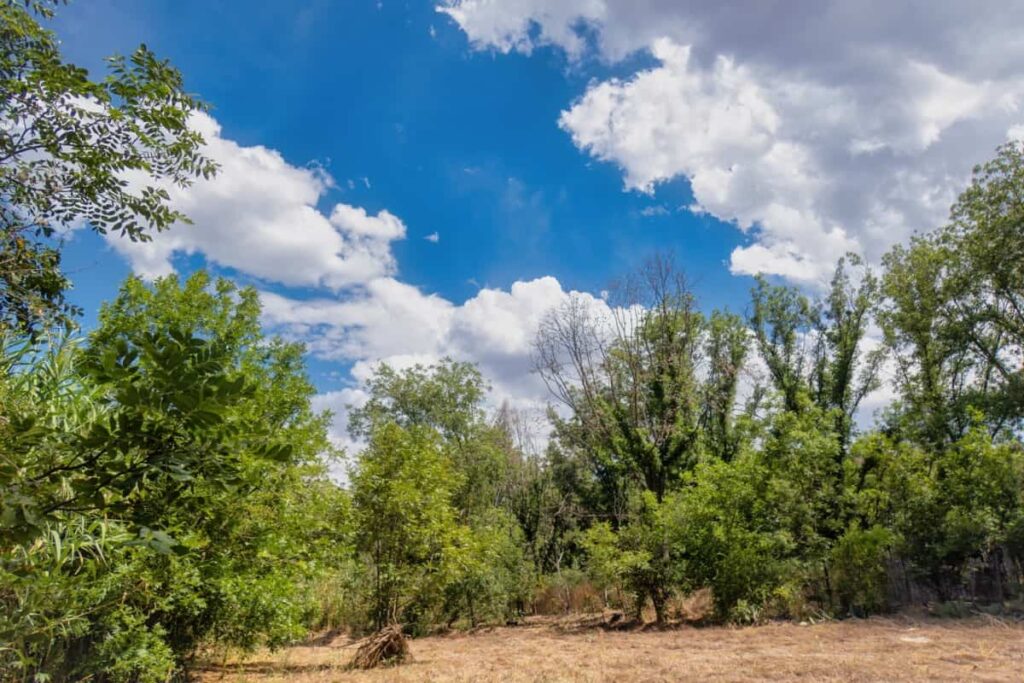
Diseases like scab, powdery mildew, and crown gall are potential threats to pecan trees. These can be managed by ensuring proper air circulation, using resistant varieties, and applying suitable fungicides as a preventive or control measure. Regular inspection and immediate action in case of pest or disease detection are vital in maintaining the tree’s overall health and ensuring a productive yield.
When and How to Harvest Pecans: Right Time and Best Method
Knowing when and how to harvest pecans is pivotal to ensure that the nuts are at their best for consumption or sale. The right time to harvest is usually when the shucks begin to split open, revealing the pecan inside. This typically happens in the fall. Harvesting can be done by shaking the branches to allow the nuts to fall or collecting them as they naturally drop.
After collecting, the nuts should be cleaned and dried properly to enhance their longevity and flavor. The best method of harvesting involves a combination of manual collection and specialized equipment for shaking, if available, to simplify the process and make it more efficient.
Pecan Tree Yield: How Many Nuts Can I Expect from My Tree?
The yield of a pecan tree is influenced by various factors such as the tree’s age, health, and environmental conditions. Young trees will produce fewer nuts, but the yield will increase substantially as the tree matures. A mature pecan tree can produce 40 to 100 pounds of pecans annually. However, this is subject to variations due to weather conditions, pest and disease pressure, and overall tree health.
Proper care, including regular watering, fertilization, and pest and disease management, is essential to maximize the tree’s productivity and ensure a plentiful and consistent yield. Understanding and managing these factors effectively is crucial in optimizing the pecan tree’s output and enjoying a bountiful harvest.
Growing Pecans in Containers: Tips for Container Growing
Growing pecans in containers is practical for gardeners with limited space or unsuitable soil conditions. Choosing the right container is the first step in this process; it should be large and durable to support the tree’s growth. Ensure enough holes in the container so water doesn’t get trapped. Use a high-quality potting mix to provide a nourishing environment for the roots.
In case you missed it: Factors Affect Seed Germination: Germination Stages: Process, Types, Tips for Successful Seed Germination
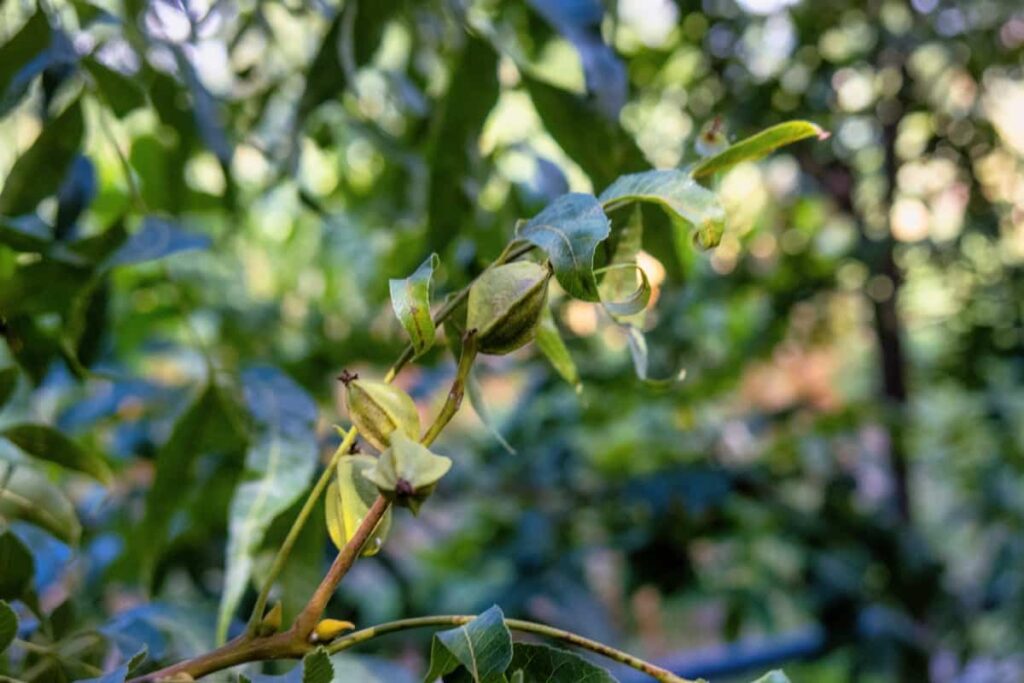
When deciding where to put the container, choose a spot with lots of sunlight and protection from strong wind or bad weather. Regular watering is essential as container plants tend to dry out faster. Also, ensure that you fertilize the tree periodically to replenish nutrients washed away with watering. Pruning and maintenance are also key in managing the tree’s size and encouraging healthy growth within the constraints of container cultivation.
How to Care Pecan Tree in Winter: Protecting from Winter Frost
Winter care is paramount in protecting the pecan tree from the adverse effects of frost and cold temperatures. Start by mulching around the base of the tree; this helps retain moisture and provides a layer of insulation to the roots. Watering the trees adequately in the fall before the onset of winter is essential, as well-hydrated trees are more resilient to frost damage.
When expecting a frost, you can also water the trees the night before, as wet soil tends to retain heat better, protecting the roots from freezing temperatures. It may also be helpful to wrap the trunk of young trees with a commercial tree wrap or burlap to prevent sunscald and frost cracks. These steps to prepare and care for your pecan tree during winter will enhance its ability to thrive and remain healthy throughout the colder months.
Overview of Growing Pecan Tree From a Nut
| Stage | Consideration |
| Seed Selection | Choose mature and healthy pecan nuts as seeds for a higher germination rate. |
| Germination | Soak the seeds in water for 24-48 hours, followed by cold stratification for 60-90 days to encourage germination. |
| Soil Preparation | Ensure the soil is well-draining with a slightly acidic to neutral pH. Amend the soil with necessary nutrients based on soil test results. |
| Planting Time | Best planted during the dormant season, preferably late winter or early spring. |
| Planting Depth and Spacing | Plant seeds about 3-4 feet deep and maintain a spacing of about 40 feet between each tree to avoid competition for resources. |
| Watering | Maintain consistent watering, especially during the early growth stages. Avoid waterlogged soil. |
| Fertilization | Utilize balanced fertilizers to enhance soil nutrients and support tree growth. |
| Pest and Disease Management | Implement preventive measures and control strategies to manage common pests and diseases affecting pecan trees. |
| Winter Care | Provide necessary protection, such as mulching and trunk wrapping, to safeguard the trees against winter frost. |
| Harvesting | Harvest pecans when the shucks split open, typically in the fall, followed by proper cleaning and drying. |
| Expected Yield | Mature trees can yield 40 to 100 pounds of pecans annually, depending on tree health and environmental conditions. |
Frequently Asked Questions (FAQ) on How to Grow a Pecan Tree From a Nut
What are Pecan Seeds?
Pecan seeds are the nuts of the pecan tree, enclosed in a hard shell, used for propagation. These seeds, or nuts, undergo a germination process to develop into new pecan trees, continuing the life cycle.
What are the Growth Stages of a Pecan Tree?
The growth stages of a pecan tree range from germination, seedling, and sapling to a mature tree. Each stage has unique characteristics, with the tree developing from a small sprout to a full-sized, nut-producing tree.
In case you missed it: Vegetable Growing Season Chart in India: Sowing Guide, Germination and Planting Calendar
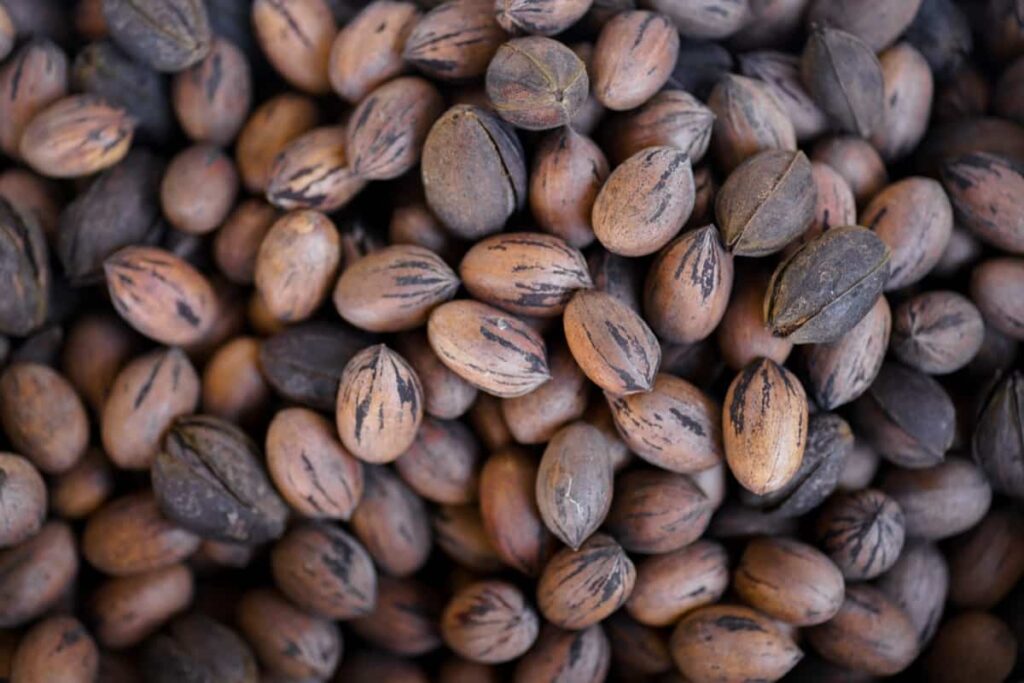
Do Pecans Grow Fast?
Pecan trees exhibit a moderate growth rate, not growing exceptionally fast. Their steady growth depends on various factors, such as environmental conditions and proper care.
How Can You Tell the Age of a Pecan Tree?
A pecan tree’s age can be determined by measuring its trunk diameter and applying a growth factor. Alternatively, counting the annual growth rings in a cut section of the tree can also determine its age accurately.
Conclusion
Growing a pecan tree from a nut is a rewarding process that involves meticulous care, from seed germination to maturity. Proper planting, watering, pest control, and harvesting practices are crucial for nurturing a healthy tree that yields plentiful pecans annually.
- Profitable Village Farming Business Ideas in 2024
- High-Yield Aquaculture: Fast-Growing Fish for Farming
- Effective Fish Pond Construction Techniques for Beginners
- Irrigation and Water Management in Pineapple Farming
- Blossom to Harvest: Mastering Flowering and Pollination in Papaya Farming
- Pig Fattening Essentials: From Selection to Sale for Beginners
- Raising Wagyu Cattle: A Complete Guide for Premium Beef Production
- Soil Types and Their Water Holding Capacity
- Optimizing Irrigation Schedules for Coconut Groves for Enhanced Yield
- Espresso Your Garden: Coffee Grounds for Healthier Acid-Loving Plants
- The Best Soil Mix for Snake Plants: How to Mix Your Own Snake Plant Soil
- Green Thumb Success: Expert Tips for Cultivating Greenhouse Beans All Year Round
- Bloom All Year Round: The Ultimate Guide to Indoor Hyacinth Care
- Eco-Friendly Gardening: How to Make Liquid Fertilizer from Kitchen Waste
- Ultimate Guide to Grow Anise in Pots: Explore Seed Propagation to Harvesting
- Guide to Raising Chester White Pigs: Discover Breed Facts to Growth Management
- Mastering the Elegance: The Ultimate Guide to Weeping Cherry Tree Care, Planting, and Maintenance
- Ultimate Guide to Planting Garlic in Grow Bags: Growing Strategies for Beginners
- How to Fix Spider Plant Leaf-Related Problems: Natural and Organic Remedies
- 10 Reasons Why Your Tulsi Plant is Shedding Leaves: Home Remedies and Solutions
- Optimizing Growth and Yield: The Advantages of Palm Bunch Ash Fertilizer
- Utilizing Neem Oil Extract as a Natural Pesticide for Hydrangea
- From Soil to Harvest: Various Ways in Which Farmers Can Use AI Tools
- Steps to Encourage and Induce Citrus Flowers: A Comprehensive Guide
- How to Fix Snake Plant Leaf-Related Issues: Natural and Organic Remedies
- Transform Your Garden into a Fragrant Oasis with Raat Ki Rani (Night Blooming Jasmine)
- Discover the Ideal Chicken Breeds for Philippine Farms
- How to Create a Poultry Egg Farm Business Plan for Profits
- Grow Lemon Cucumbers Like a Pro: Insider Techniques for Bountiful Yields
- Ultimate Guide to Caring for Your Pink Princess Philodendron: Tips for Thriving Variegation
- Areca Nut Profit Per Acre: Calculating Yield and Cost of Cultivation
- How Kaveri Chicken is Becoming a More Profitable Breed in Indian Backyards
- Transform Your Barn: 9 Steps to Convert a Horse Stall into a Chicken Coop
- Exploring Suffolk Sheep Disadvantages with Limitations and Challenges
- Guide to Solving Potted Lemon Tree Problems: How to Revive Lemon Tree in Containers
- Steps to Encourage Female Pumpkin Flowers: Best Strategies for More Flowers and High Yields
